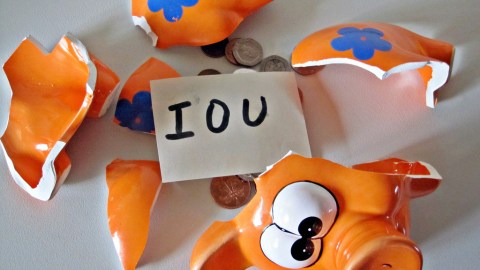5 realistic ways to save money, according to experts

- U.S. household debt reached an all-time high in 2018, a year that also saw a severe drop in the personal savings rate.
- While the internet propagates many untenable ways to save, experts agree that small changes to our lives can result in large paybacks.
- These five ways to save money can lead to improved health and living a little greener.
The internet is replete with advice on how to save money, but it can be difficult to find information that’s right for you. The FIRE movement promises that prudence will lead to retirement in your 30s, but its critics argue that such a path is only accessible to the economically elite. Then there are the attention-grabbing methods that clog your social media feed: recycling pet hair for pillow fluff, making your own toilet paper out of junk mail, and extreme-couponing your way to a truck-load of free Pop-Tarts.
While these methods may ultimately save you money, none of them are necessary (or appealing) and they can sacrifice quality of life. But there are less sensational, far more realistic ways to go about saving money. To find them, we simply need to reevaluate everyday spending habits to locate our psychological blind spots. Thankfully, scientists and experts have taken the time to locate these blind spots for us, quantifying exactly how much money we’re leaving on the table without a second thought.
Credit cards are financial leeches
For many the monthly credit card statement is treated like any other utility bill. They pay the minimum balance and then don’t think about it until the following month. This approach, however, makes the charge card little better than a financial sink hole.
How much can it cost you to fill it in? Imagine you owe $7,000 with an interest rate of 15 percent. Paying $300 a month, it’ll take you 28 months to pay off the debt. In the end, you’ll pay $328 more than the principal—assuming you don’t take on additional debt during that time.
The more you owe, the more you pay. If you owe $20,000 a month at 15 percent interest, and pay $1,000 per month, it will take you 24 months to pay it down. The debt will ultimately cost you $3,158 more than the original cost of the items and services.
Of course, $1,000 is a lot to set aside per month, but it’s necessary. Paying only the required minimum payment covers the interest alone. This leaves the principal untouched, allowing it to continue generating higher and higher costs.
“Credit card debt is the stain on millions of Americans’ finances that doesn’t scrub off easily, if ever,” said Kimberly Palmer, NerdWallet’s credit card expert. “High interest rates combined with expenses that continue to outweigh income mean that some households are unable to fully rid themselves of debt and, in fact, continue to take on more.”
Palmer’s statement may conjure images of welfare queens on shopping sprees, but such stereotypes are hardly accurate. One survey discovered that “nearly two-thirds of Americans with credit card debt most typically rack it up due to emergency expenses, like car repairs or medical bills, or to daily spending, like groceries or utility bills.” Corroborating this, a NerdWallet study found that while income growth has outpaced inflation, increasing by 22 percent since 2008, medical expenses have risen even faster (33 percent since 2008).
If you want to improve your finances, make filling in this money sink your top priority. After paying it off, or significantly down, take the money you would have spent on monthly payments and put it into a rainy-day account. This will help you from building up the debt as aggressively next time you go to the doctor.
(If you want to calculate how long it will take you to clear your personal debt, you can find a credit card payoff calculator here.)
Exercise trims more than your abs
In a New York Times/CBS News poll, nearly half of respondents agreed with the statement that affording basic medical care was a hardship. Out-of-pocket expenses have risen, forcing many Americans to compensate with debt. This includes credit card debt, as we’ve seen, but also borrowing against their home.
It’s a miserable truth in the United States that people must choose between their well being and financial security. Of course, if you need to go to the doctor, do so. To help you save on those visits, you should exercise regularly.
A study published in the Journal of the American Heart Association compared the workout habits of American adults with their medical expenses. People who exercised regularly—roughly 30 minutes a day, five days per week—cut their medical costs by an average of $500 per year compared to non-exercisers.
The windfall was even larger for people with preexisting conditions. Exercisers with cardiovascular diseases (CVD) spent an average of $2,500 less on medical bills than non-exercisers with CVD.
“This study gives us even more solid evidence that physical activity has a significant effect on health,” Dr. Jorge Plutzky, director of preventative cardiology at Brigham and Women’s Hospital in Boston, told the Men’s Journal. “Exercise brings many different forces into play that can benefit you, such as weight loss — and it’s amazing what can happen when you lose even just a little weight. Blood pressure, cholesterol, and inflammation all go down. You just can’t put all those benefits into a pill.”
Driving costs down
Walking, running, and biking are great ways to get exercise. Not only will these activities help you stay healthy, they’ll cut down on another major financial burden, your car.
A 2018 AAA study found the average cost of owning and operating a new vehicle was $8,849 per year. Small sedans and hybrids cost the least ($6,777 and $7,485, respectively), while large sedans and pickup trucks cost the most ($9,804 and $10,215). The depreciation was shown to be a massive value sink as well, amounting to 40 percent of vehicle-owning costs.
“The secret to minimizing depreciation costs?” said John Nielsen, AAA’s managing director of Automotive Engineering and Repair, in a statement. “Keep your car for a long time and keep it well-maintained or even consider buying a quality, pre-owned vehicle.”
You can claw back that annual $9,000 simply by owning one fewer vehicle. You can further cut expenses by using public transportation, performing routine maintenance, driving at moderate speeds, and only buying premium gas if your vehicle requires it.
Reducing car use is a good way to go green, too. The American Public Transportation Association cites public transportation as saving the U.S. “4.2 billion gallons of gasoline annually” and reducing “the nation’s carbon emissions by 37 million metric tons annually.”

The convenience of snagging a fast-food lunch hides a hidden costs. Not only is it not healthy for you, but it costs significantly more than packing your own lunch.
The value of a home-cooked meal
Busy schedules lead us to dine out for the convenience factor, but this convenience costs the average American a surprising amount. A Visa 2015 lunch survey found that Americans who eat lunch at a restaurant twice a week spent $1,043 a year, plus expenses for the other three days. Americans who brown-bagged it spent slightly more ($1,704) to eat five days’ worth of lunches.
And the expense of dining out is increasing. According to the NerdWallet study, “the cost of buying food away from home has gone up 27 [percent] since 2008, outpacing the growth of the U.S. median income.” Planning your meals in advance not only cuts down on these oft-ignored costs, but also allows you to be more judicious in the foods you eat.
Coffee out is another great place to save. Crunching the numbers, Coffee & Conservation found that brewing a 12-ounce bag of specialty coffee at home costs you around 50¢ a cup. A Starbucks 8 oz. drip coffee will cost you roughly four times that amount. And let’s be honest, few of us enjoy Starbucks for their drip.
“You might opt to keep some of [life’s] extras, which is totally fair, but getting clear on what counts as a necessity can help you really enjoy your discretionary purchases more,” personal finance blogger Desirae Odjick told NBC News. “You don’t need a latte, but that doesn’t mean you can’t enjoy one—and if you know it’s a treat, as opposed to what you buy without thinking about it because you need it, you’ll probably enjoy it more.”

The modern supermarket is a psychological maze designed to keep you inside and spend more. To save money, stick to a specific list and limit your time there.
Understand the psychology of supermarkets
TV shows tout the massive savings of extreme couponing, but in the long run, sales and coupons cost you. They’re designed to get you in the store, where you will spend more money on premium-priced items. And these sales are often on items you wouldn’t have purchased in the first place. Sure, you got 50 boxes of Pop-Tarts for free, but how many Pop-Tarts are required to meet Maslow’s Hierarchy of Needs? The answer is no Pop-Tarts.
Beyond the so-called deals, supermarkets are laid out to tempt your brain into purchasing more than you need. Endcaps push sales front and center. Samples slow you down and add entertainment value. Staples like eggs and dairy are placed in the back, forcing you to schlep through the entire store. Even the aisle layout is designed to keep you in the store longer, increasing the chance you’ll buy just one more item.
To save, shop less. Go to stores less often, spend less time there, and make a list beforehand. This will offer fewer opportunities to spend money on things you don’t need. After all, if you don’t wander down the soda aisle, you won’t place that tempting Coca-Cola bottle within arm’s reach.
Calculating the list’s costs and bring that exact amount of cash can also help prevent overspending. And never go shopping hungry. Eat a snack at least.
Another way to save is to ignore brands. Our brains associate reward with specific brands, with aggressive marketing intensifying that relationship. However, name brands (aka private label goods) tend to sell at a higher price than store brands despite not providing any added quality.
“The neuroscientist Read Montague demonstrated that merely seeing a Coke label was enough to activate the brain’s pleasure centers without even taking a sip, by elevating the levels of dopamine, a naturally occurring chemical produced by the brain that signals feelings of reward,” writes Douglas Van Praet, author of Unconscious Branding: How Neuroscience Can Empower (and Inspire) Marketing. “The way we plan future behavior is based upon present feelings that signal future expectations: The more rewarding it feels, the more likely we are to engage in that activity.”
Consumer Reports studieshave shown that store brands are less expensive than national brands by about 25 percent, and their testing has revealed no significant quality difference (though some store brands are superior to others). Their surveys have also shown that the majority of store brand buyers are satisfied. The reason for the cost distinction? You’re paying to supplement the name brands’ fierce marketing campaigns.
This article has focused on short-term money goals, none of which is complete without long-term planning. Budgeting, investments, insurance, retirement savings, and rainy-day funds all need to be considered for a well-rounded approach to one’s household finances. But these tips—along with others like using the library, conducting an energy audit, or learning to do your own home repairs—can help you claw back some of the savings that go unnoticed every day.
If your personal moonshot is to become a millionaire, and kind of soon, try this.





